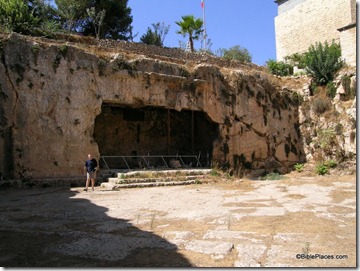The most impressive tomb in all of Israel from any of the biblical periods is the “Tomb of the Kings.” Despite its modern name, the tomb actually belonged to Queen Helene of Adiabene, a royal convert to Judaism from a Mesopotamian kingdom. Her tomb was constructed about a decade after the crucifixion of Jesus a few hundred meters north of the Garden Tomb. Gaining access to the tomb today is more difficult than the average tourist site, but it is well worth it.
One thing you will not see at the tomb, however, is Queen Helene’s sarcophagus. This 2,600-lb (1,200 kg) stone coffin was shipped to the Louvre following the tomb’s excavation in the 1860s. I’ve hunted around the French museum looking for this sarcophagus, but without success. The object has been safely stored in the basement for years and years. Nevertheless, the French were reluctant to loan the sarcophagus to Israel where people could actually view it. After a year of negotiation, the sarcophagus has arrived at the Israel Museum where it will be on display for four months as part of the exhibition, “Breaking Ground: Pioneers of Biblical Archaeology.”
Queen Helene is not mentioned in the New Testament, but there is a connection. Josephus (Ant. 20.2.5) writes that she supplied food for Jerusalem during the famine that is mentioned in Acts 11:27-30.
During this time some prophets came down from Jerusalem to Antioch. 28 One of them, named Agabus, stood up and through the Spirit predicted that a severe famine would spread over the entire Roman world. (This happened during the reign of Claudius.) 29 The disciples, each according to his ability, decided to provide help for the brothers living in Judea. 30 This they did, sending their gift to the elders by Barnabas and Saul.
Haaretz tells the story and provides a photo. For more about the tomb itself, including photos and links, see this page at BiblePlaces.com. Several years ago, archaeologists working in Jerusalem claimed that they located her palace in the City of David.
